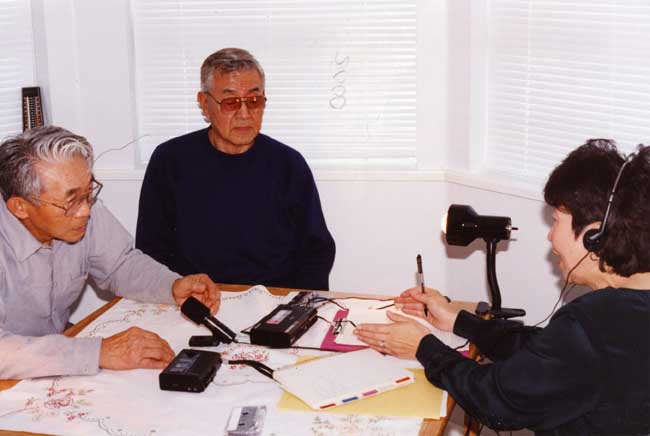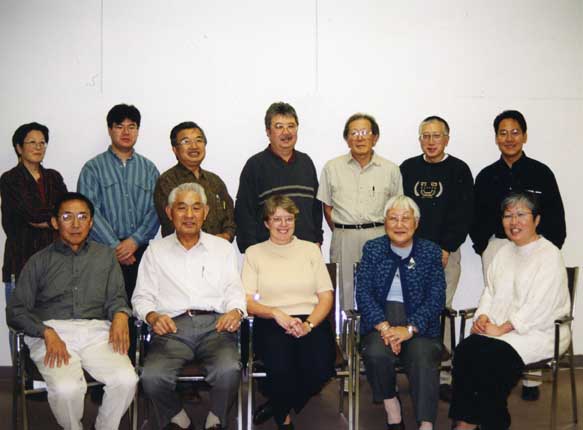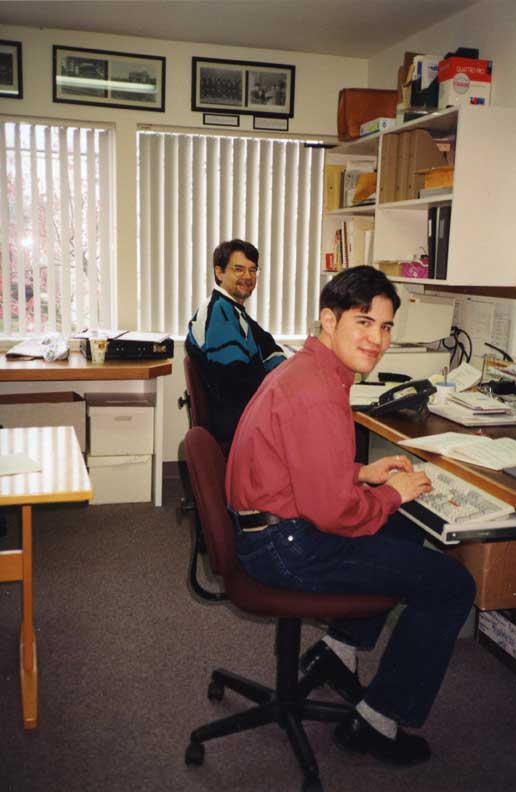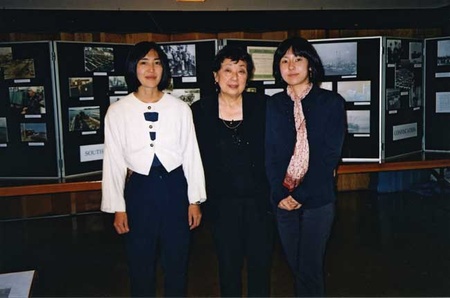The Centennial of 1977 celebrating the arrival of Manzo Nagano, the first Japanese to land in Canada, inspired many younger Nisei to start learning about their history and heritage. In the early 1980s, Frank Hanano formed the Japanese Canadian History Preservation Committee (JCHPC) as a sub-committee of the Greater Vancouver Japanese Canadian Citizens’ Association (GVJCCA). This committee included Suni Arinobu, Tsuneharu Gonnami, Tatsuo Kage, Frank Hanano, Yuko Shibata, Junji Uchimura, and myself, Frank Kamiya. This committee realized the importance of preserving the history of our elders who were aging and passing on.
Over the next few years, the committee recruited dedicated volunteers who recorded some 50 interviews that were later forwarded to the UBC Special Collections for safekeeping, subsequently copied and given to the Japanese Canadian National Museum (JCNM). They also collected many archival documents and photographs that we heard were being discarded by some families. This important work was the foundation for the collections of the JCNM.

From 1984 to 1987, Dan Tokawa, and I after him, continued the work of the JCHPC by hiring summer students through grants and recruiting dedicated volunteers who conducted and transcribed many more interviews. With limited funds the committee purchased tape recorders, a transcriber, a 35-mm camera, a filing cabinet, and some archival supplies. Gradually, through fundraising, and with some financial assistance from the Japanese Canadian Redress Committee and GVJCCA, the committee was able to upgrade the equipment that included a used professional grade tape recorder, fireproof storage cabinet, and hire part-time staff and summer students through grants.
In 1993, the JCHPC officially became the Japanese Canadian Archives (JCA). With limited secure storage space the committee was only able to accept archival material and continued to record interviews. Shane Foster who took several archival courses was hired as a part-time archivist in the early 1990s to maintain the Archives. Lana Panko, with a museum background, provided essential guidance on the operations. By 1994, the JCA had over 1,000 historic photographs and 234 oral history recordings in both Japanese and English.

On June 22, 1995, with endorsement from the National Association of Japanese Canadians (NAJC) at their AGM in Kamloops in 1994, the Japanese Canadian National Museum and Archives Society (JCNMAS) was federally incorporated. With substantial funds provided by the Japanese Canadian Redress Foundation, the Society hired qualified staff: including an executive director Dr. Michael Wilson, curator of collections Susan Michi Sirovyak, curator of programs Naomi Sawada, Shane Foster continued as archivist, and Minnie Hattori as part-time office assistant. Suzi Nitta Petersen was our General Secretary, Ray Ota was our treasurer who ensured that our finances were in order, and I was the founding president.

The purpose of the JCNMAS was “to collect, preserve, research, exhibit, and interpret historical artifacts and archival material covering the history and culture of Japanese Canadians from the 1880s through World War II to the present day.” The first office of the JCNMA was a 190 sq. ft. space on the second floor of the GVJCCA office at 511 E. Broadway, Vancouver. Some of the furniture and equipment were donated or built by volunteers. We still use some of these desks and filing cabinets today.
In January 1996, the first issue of our quarterly journal NIKKEI IMAGES was published. Edited by Michael Wilson, it is now published three times a year and is also available online. A new logo was designed by Gerry Foster, son-in-law of director Dr. Wesley Fujiwara, using the traditional Japanese mon motif in a simple and pleasing way with maple leaves, the symbol of Canada. In 1999, the JCNMA officially changed its name to Japanese Canadian National Museum (JCNM) as it was felt that “Archives” was redundant.
Some of the museum events and projects that the early JCNM was involved with include the following:
- Since the mid-1980s, provided historical displays and conducted walking tours at the annual Powell Street Festival. Some of the volunteers and former directors still conduct tours to this day.
- Researched and produced for sale the Powell Street area map “–1941”.
- In 1989, worked with the Consulate of Japan on their Vancouver Centennial Joint Photo Display.
- Participated in the Pan American Nikkei Association (PANA) Conference in Vancouver (1993) and Peru (1996) with a photo display and members of panelists.
- Sponsored thirteen Nikkei from across Canada to attend the Japanese American National Museum (JANM) International Nikkei Symposium in Los Angeles in 1994 with a historical photo display and also participated as panelists.
- Partnered with JANM’s International Nikkei Research project.
- Organized many successful BC Internment Camp bus tours that attracted people from across Canada, the USA, and Japan.
- Initiated fundraising events including the Spring Manure and Plant Sale, Things Japanese Sale, Powell Street Festival Food booth, and the traditional Mochitsuki at the end of the year. Many present members of the NNMCC Auxiliary were former museum members who have continued some of these fundraising events.

In the spring of 2000, after many years of volunteer initiatives, the JCNM moved into a 2,870 square foot space in the newly constructed 34,000 sq. ft. NNHC building. After many years in cramped quarters, we were thrilled to have an 1,140 sq. ft. exhibition hall, a 530 sq. ft. environmentally controlled archival storage with preparation area, museum offices, a research/resource centre, and a museum shop where Suzi Petersen took on the task of establishing and managing the shop that provided much needed revenue. Grace Eiko Thomson, who began as Executive Director in 1999, secured funds for the inaugural exhibition that she curated and titled Reshaping Memory, Owning History: Through the Lens of Japanese Canadian Redress. The exhibition successfully toured Canada and an abridged version is currently used in education programs. The museum was able to flourish in the new premises with exciting exhibits and a growing collection. In addition, several educational programs were developed, including the Taiken Program and the Journeys Outreach kits. To date, over 14,000 students have learned about the history of internment through the museum’s educational programs.
In 2002, Stan Fukawa was elected as the second President, and in June of that year the membership approved the merger of the JCNM with the National Nikkei Heritage Centre Society. This was a critical event for both organizations as both societies had similar missions and goals and cooperation was seen as more fruitful than competition. The merger agreement was formally signed in May 2003 to create the new society, as the National Nikkei Museum and Heritage Centre (NNMHC). Since that time the museum has been actively involved in many important community and historical events. The 2002 Nikkei Week celebrations highlighted both the 125th anniversary of the arrival of the first Japanese immigrant to Canada, Manzo Nagano, and the centennial of the fight for citizenship rights for Canadians of Asian origin taken to the Privy Council by Tomekichi Homma.
In 2003, Jari Osborne presented the world premiere of Sleeping Tigers, an NFB film about the Vancouver Asahi baseball team at the NNMHC Events Hall in recognition of the help that was given to her by the JCNM. In October 2005, the JCNM opened the exhibition Leveling the Playing Field: Legacy of the Asahi Baseball Team, curated by Grace Eiko Thomson. This exhibit also traveled across Canada.
In 2006, the SUIAN MARU Centennial project and celebration introduced the fascinating story of the 1906 voyage of the SUIAN MARU, a three-masted schooner that transported 84 people from Miyagi Prefecture to the BC coast. It was part of Jinzaburo Oikawa’s dream of establishing a colony of people to turn British Columbia’s then scrap fish, the chum salmon and salmon roe, into valuable trade commodities in Japan as salted salmon and salted roe. Through the involvement of people in the Nikkei community with contacts with the Oikawa family, the museum was able to receive the family’s historic collection of artifacts including Jinzaburo’s hand-written autobiography, clothing, and many photographs. The SUIAN MARU Centennial program attracted visitors from Japan and descendents from across Canada and the U.S. Almost 400 guests gathered in the Nikkei Centre Events Hall for the sold-out dinner. The museum staff created a SUIAN MARU exhibit from artifacts received shortly before the celebratory event that was received with great appreciation.
In July 2009, the NNMHC hired Beth Carter as Director–Curator. She was previously Curator of Indigenous Studies with the Glenbow Museum in Calgary, Alberta. Beth brought to the museum her expertise in managing a major museum and her many contacts in her field to advocate for grants and collaborative ventures across Canada. The NNMHC has worked closely with the Nikkei Internment Memorial Centre in New Denver and the Kamloops Japanese Canadian Culture Center assisting with their operations, and assisting the Japanese Canadian Cultural Centre in Toronto with their archives. All three have catalogued their holdings onto the museum database that is fully accessible to the public at www.nikkeimuseum.org.
In 2012, the NNMHC rebranded and now is known as the NNMCC, the Nikkei National Museum & Cultural Centre. The Nikkei National Museum (NNM) has curated many diverse exhibits, produced mainly by the staff on modest budgets to interest an international audience. Beth has worked with the building committee and the architect, Ken Takeuchi, to develop a future expansion plan on the second floor that would double the Museum area. The NNM has curated the Taiken history panels on the second floor corridor walls as well as utilizing walls in some offices with historic photos.
After nearly 6 years, Beth Carter moved on to become the curator at the Bill Reid Gallery of Northwest Coast Art in Vancouver. In May 2015, Sherri Kajiwara was hired as director/curator of the NNM and already has planned programs and events into 2018. In addition to the inaugural exhibitions already mentioned, important projects curated at the NNM within the last five years include:
- Monogatari: Tales of Powell Street 1920–1941
- Ryoshi: Nikkei Fishermen of the BC Coast
- Call for Justice: Fighting for Japanese Canadian Redress
- Revitalizing Japantown? A Right to Remain Exhibit
Select online exhibits include:
For full exhibition details past and present, please see the NNMCC website at www.nikkeiplace.org.
The Nikkei National Museum is the result of many volunteers who had the foresight and vision to save the heritage of the community for future generations. The Museum is excited to celebrate second decade and continues to be dedicated to the care and preservation of important Japanese Canadian historical records and artifacts from across the country.
The museum is committed to the highest standards of preservation for the collections and is using new technology to digitize collections and make them available to a much wider audience through the internet. We continue to work together with several community groups and centre’s across Canada to gather historical information and prepare exhibits that we hope to share. We are also excited to feature younger contemporary artists who are looking to the future and interpreting their Japanese Canadian ancestry through new media. As the collections grow, we look forward to expanding the museum into a larger permanent history gallery that will truly reflect the national scope, significance, and influence of Japanese Canadians. As our Nisei and now our Sansei age and pass on, we encourage all Nikkei to assist the NNM to record and preserve your family history and share with all Canadians through the Nikkei National Museum & Cultural Centre. Help build and maintain YOUR Museum and Cultural Centre for future generations!
*This article was originally published in Nikkei Images, Winter 2015, Volume 20, No. 3.
© 2015 Frank Kamiya



